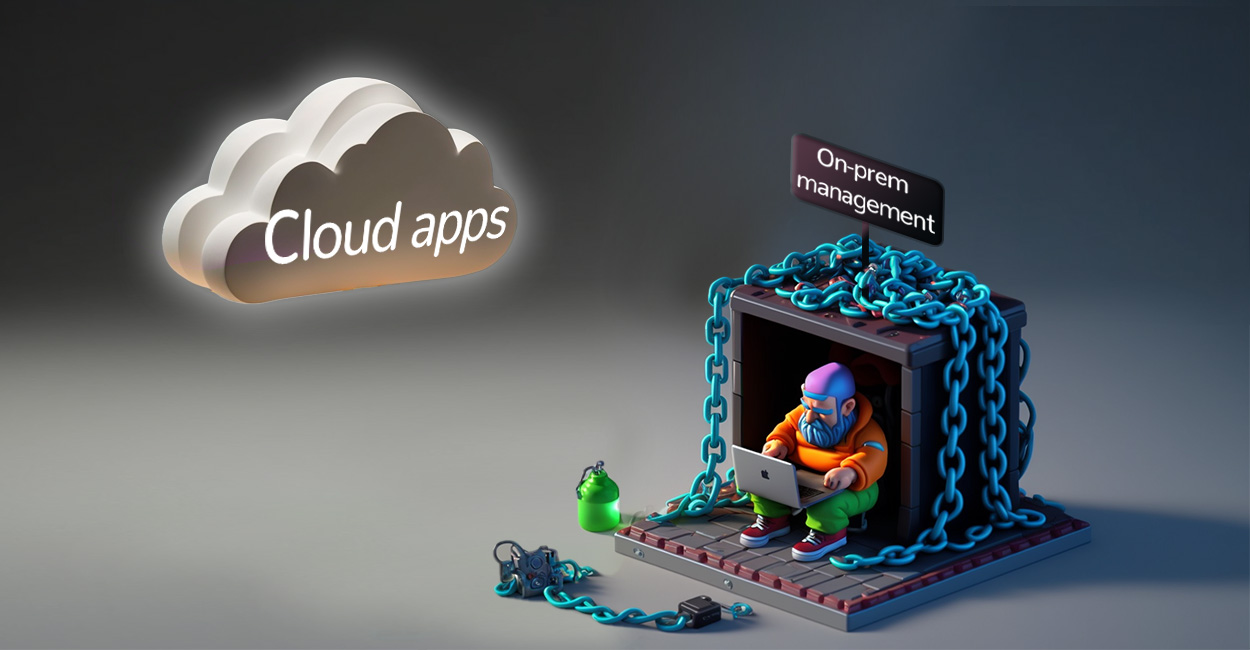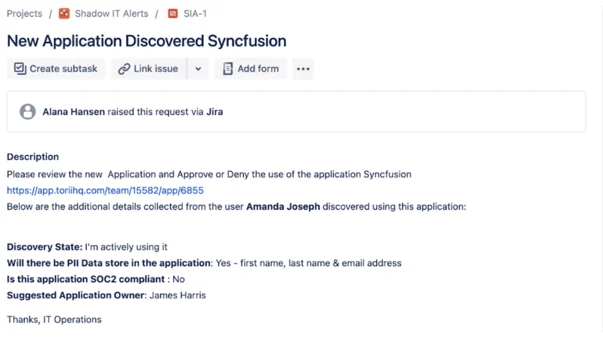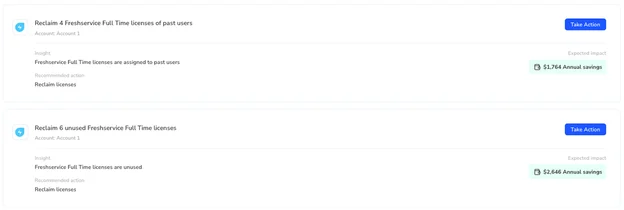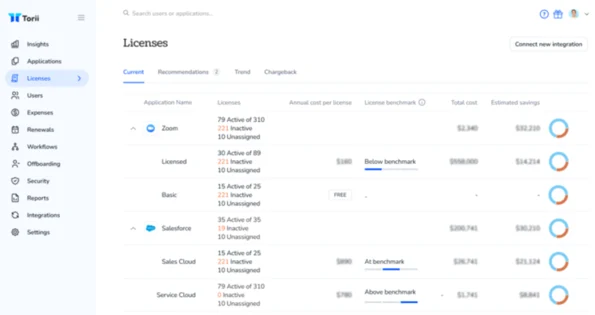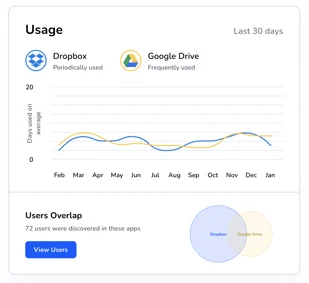💡Key Points:
- IT Asset Management (ITAM), Software Asset Management (SAM), and SaaS Management Platforms (SMPs) all serve crucial, yet differing purposes when it comes to managing technology.
- With quickly increasing adoption of SaaS apps, SMPs must start filling the gaps in ITAM and SAM solutions.
- SMPs are used for complete Shadow IT discovery, and surfacing actionable, cost-saving opportunities.
- SMPs automate risk management and cost-saving opportunities in ways that SAM and ITAM tools don’t.
The Roles of IT Asset Management and Software Asset Management
Companies have always needed a way to track their technology assets. From tactile employee hardware like phones and laptops to the software that made computers truly valuable like Microsoft Office or SAP ERP.
While this reality hasn’t changed—hardware and software remain the crux of companies’ existence—the ways in which software is procured, deployed, and managed definitely has.
Let’s be frank. On-prem software, its flash drives, and in-person audits are being usurped by cloud software, or SaaS. While larger, older companies still leverage on-prem tools, not quite willing (or able) to part with their costly investments, the agility and flexibility of SaaS apps have made most of these companies’ tech stacks hybrid. Meaning, they have to find ways to manage both on-prem and cloud-based apps.
So, where do ITAM and SAM come into play?
Before the SaaS explosion the easy answer to managing a companies’ tech stack was to onboard one or both of these solutions.
Information technology asset management (ITAM) tracked all of a company’s assets, placing equal emphasis on hardware and software, while software asset management (SAM) tackled on-prem solutions, and would later go one to address select SaaS applications, all of which were sanctioned or e adopted and approved by IT.
But today, rising rates of SaaS adoption, its associated costs, and risks like Shadow IT have created a gap in ITAM and SAM offerings.
To put it simply, neither ITAM nor SAM can efficiently discover, manage, and optimize a companies’ entire SaaS stack. This can lead to some serious and costly consequences.
Gartner touches upon these risks, and their cause, in their 2022 Market Guide to SAM Tools:
“Organizations find it challenging for a SAM tool to support the modern demands of asset management. The biggest issue organizations face today are the vast number of SaaS applications utilized from a growing number of providers, requiring an approach that enables metering across each of those. […] [These challenges cause] significant expense and risk combined with unique and/or uniquely complex license management challenges.”
But don’t worry, just because you have a hybrid tech stack doesn’t mean your sensitive data and bottom line are doomed.
You just have to adapt.
This is where adopting a SaaS management platform (SMP) comes into play.
SMPs Fill ITAM and SAM Gaps
Whether you’re planning on sticking with a hybrid tech stack for the long haul or have ambitions of going fully cloud, adopting an SMP will help you cover crucial (and costly) SaaS management gaps now and in the future –without adding extra work to your plate.
SMPs can and should be used simultaneously with ITAM and/or SAM platforms to effectively manage hybrid tech stacks or on their own to manage your cloud ecosystem.
That’s because SMPs provide three crucial SaaS management capabilities currently missing in SAM offerings:
- Continuous Shadow IT discovery
- Actionable cost-saving insights and recommendations
- Automated cost-saving actions and workflows
Shadow IT Discovery
How ITAM, SAM handle Shadow IT
Just to recap, ITAM and Software Asset Management systems can manage SaaS applications, but only a select few (all of which must be sanctioned).
This is because they rely on API or native integrations to develop app catalogs, as well as manage costs, users, and risks.
Here’s the catch: relying on API integrations to visualize your tech stack means you’re missing crucial discovery methods to detect Shadow IT.
Unfortunately, the ease of adopting SaaS apps has led to over 50% of a company’s tech stack to remain in the Shadows. That leaves half, if not more, of your apps unmanaged when relying on traditional ITAM or SAM services.
These unmanaged apps not only fuel wasted spend, inconspicuously charging hundreds to thousands of dollars to company credit cards, but also have your company’s sensitive data constantly flowing through them without any IT or security professional managing user access or security breaches.
How SMPs handle Shadow IT
Complete SaaS Management Platforms like Torii, on the other hand, use multiple discovery methods to continuously detect Shadow IT and reveal an always up-to-date view of your true tech stack.
By continuously ingesting and parsing through Oauth, IdP, SSO, and financial data, SMPs can detect expense or application anomalies— those that don’t match your company’s sanctioned tech stack.
Plus, a few select SMPs such as Torii offer a secure browser extension as additional discovery source, one proven to discover more Shadow IT apps then any aforementioned method. These extensions not only detect newly adopted applications as soon as they occur but also capture real-time usage metrics to help ensure compliance.
Note: Before deploying your SMP’s discovery-based browser extension, it’s critical to confirm that no cookies, login information, or browsing history is collected by their platform, and that all SaaS analysis is occurring locally, on the client side. Additionally it’s vital that the browser extension only discovers apps procured via an a corporate account, not personal one, in order to properly maintain employee privacy.
But, just gathering Shadow IT data isn’t enough. You need a way to instantly act on it.
Sophisticated SMPs like Torii will turn Shadow IT insights into automatic and actionable alerts and provide the capability to trigger application reviewal workflows.
This level of automation and overall actionability brings us to our next SMP differentiator—cost-saving insights and recommendations.
Cost-Saving Insights and Recommendations
How ITAM and SAM handle cost-savings
I know what you’re thinking, “cost-saving insights have always been a critical capability for software asset management tools,” and you’re right….well, sort of.
ITAM and SAM solutions do offer license compliance and vendor management insights, but they were specifically built to address an inherently on-prem-related challenge, license and/or vendor audit defense.
Unlike SaaS applications where adding or removing licenses is inherently flexible, on-prem software typically provisions a set amount of licenses for a given contract period.
In order to enforce license compliance—that your company is only using the contractually agreed upon amount of provisioned licenses, not more—on-prem vendors will conduct a license audit once or more within that contractual period.
If you’re caught with extra licenses, your company will experience a “true up” and be charged for each additional license backdated to the start of your contract term.
With this in mind, ITAM and SAM spend optimization insights mostly revolve around license usage, simply detailing how many licenses are included in your contract and how many have been assigned.
What’s more, these insights are exactly that, stagnant insights, with little to no actionability attached to them.
For example, while preparing for a Jira audit you notice you’ve provisioned two extra licenses and must find a way to quickly deprovision them in order to stay compliant. This being said, you want to make sure employees relying on Jira will maintain access to it. But, without a unified and actionable view of Jira license and usage data, it’s nearly impossible to efficiently identify which employees actually use Jira and which ones have abandoned their licenses.
Instead, you have to manually parse through the application’s licenses, finding two with low to no usage, and then leave the SAM platform to manually reclaim them within Jira.
As you can imagine, this incredibly time-consuming and error-prone process relies heavily on an employee’s attention to detail, often leading to missed cost-saving opportunities and wasted spend.
How SMPS handle cost-savings
SaaS Management platforms, on the other hand, not only provide unified license, usage, spend, and contract data, but also streamline cost-saving processes with actionable recommendations and workflows.
Torii, for example, leverages deep feature engagement to automatically generate license recommendations, allowing you to quickly reclaim, deprovision, or downgrade unused, past, and underutilized license with a click of a button.
All you have to do is visit the aptly titled “recommendations tab,” click “take action” on your desired cost-saving opportunities, and sit back as you watch your SaaS costs plummet.
But that’s not all. On top of license recommendations, SaaS Management Platforms provide an additional slew of ways to save.
The best part is most of these cost-saving opportunities are automated, ultimately lowering your total cost of ownership by cutting SaaS spend and operational costs.
Automated, Cost-Saving Action and Workflows
SaaS is one of the largest costs for an organization, with “enterprise software spending forecast[ed] to reach $754.8 billion in 2023” according to Gartner.
With this in mind, it’s no surprise a large portion of cost-saving opportunities stem from renewals, or an SMPs application, license, and overall renewal rationalization capabilities.
While SaaS is no doubt a necessity for scaling organizations, the ease of adopting SaaS apps, the rise of Shadow IT, and increasing amounts of wasted spend all contribute to this staggering figure.
That’s why it’s so important to rationalize your SaaS stack and right-size your SaaS subscriptions.
Lucky SaaS Management platforms like Torii make vendor and renewal management a breeze with a dynamic renewal calendar, automatic notifications, side-by-side app comparisons, and license cost benchmarking.
You can view all of your renewals at a glance and receive several notifications nearing the renewal period to begin rationalizing your current subscription.
To prepare, SMPs enable you to strategically plan your SaaS stack by comparing contract data with app usage, adoption, and cost insights, all in one place.
Additionally, you can immediately understand if your subscription price is “at”, “above,” or “below” market value by comparing your license costs to similar companies’ with license cost benchmarking.
Finally, you can eliminate redundant tech by easily discovering similar apps used in your organization with side-by-side app comparisons.
SMPs like Torii will automatically suggest comparison recommendations based on app feature similarities, employee usage, and license overlap.
These robust comparisons allow you to drill into overlapping users and usage trends, quickly revealing how engaged your employees are with each app and which employees should receive a questionnaire regarding their duplicative licenses.
In addition to renewal reminders, SMPs like Torii can also automate alerts for new SaaS spend, unused applications, and Shadow IT adoption, enabling IT and procurement to immediately manage unsanctioned and wasted spend.
To expedite time from insights to savings, Torii’s advanced data engine also allows you to automatically send customized questionnaires to new application owners and trigger application reviewal processes.
All of these automatic recommendations, reminders, and workflows allow you to save big while investing less time and resources into managing your SaaS stack.
Check out how Torii’s cost-saving opportunities can help you!
Better Together: ITAM/SAMs and SMPs
Whether you’re in love with your on-premise services, a SAM/ITAM fanatic, or cloud-first believer, one thing remains true—you can’t deny or escape SaaS’ gradual takeover.
Every company, no matter its size or industry, is increasingly relying on SaaS applications for their scale, iniquity, and agility… but not every company is properly managing these assets.
Just as the tech market continuously innovates, so too should our software management practices.
Otherwise, we’re left with incomplete discovery, rampant spend, and unchecked security risks.
Luckily, adopting an SMP can fill the gaps in your existing ITAM or SAM solutions, securing your sensitive data while increasing your return on SaaS investment.
